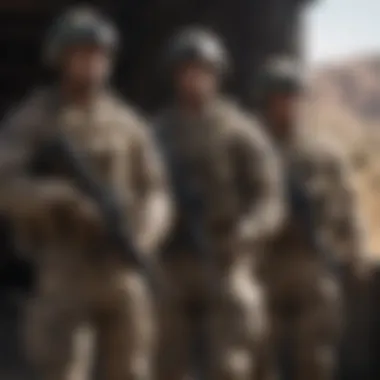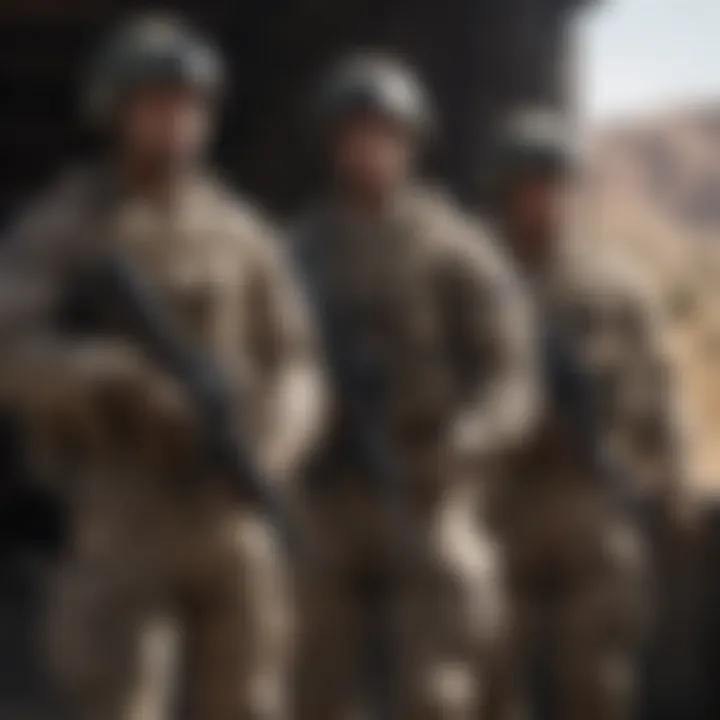The Evolution and Impact of US Army Airborne Forces


Intro
The evolution of the US Army Airborne Forces is a story rich in history and significance. From their inception in the early 20th century to their crucial role in modern warfare, these soldiers have demonstrated remarkable adaptability and resilience. Understanding their evolution sheds light on their operational impact and cultural relevance.
Airborne forces are characterized by their ability to deploy rapidly, often through parachuting, directly into combat zones. This method allows for strategic flexibility and the element of surprise. The training required to become an airborne soldier is rigorous, demanding both physical and mental endurance. Those who succeed in this environment are part of an elite community that plays a vital role in military operations.
Key operations throughout history underline the effectiveness and strategic significance of airborne units. They have participated in pivotal moments, such as the Normandy invasion during World War II and more recent conflicts in the Middle East. Each operation not only showcases their military capabilities but also highlights the advancements in airborne tactics and technology over time.
In addition to their military significance, airborne forces have made a cultural impact. They embody qualities like bravery, teamwork, and commitment, resonating with both military personnel and civilians. Their portrayal in media and popular culture reinforces their heroic status.
This article will explore the various facets of US Army airborne forces, focusing on their historical progression, operational effectiveness, and cultural representation. By examining these aspects, readers can appreciate the continued relevance of airborne forces in today's ever-evolving military landscape.
Historical Context of Airborne Operations
The historical context of airborne operations serves as an essential framework for understanding the evolution and operational significance of the US Army Airborne Forces. This context traces the ideology and strategies that have influenced airborne tactics and operations from their inception to present day. Grasping the origins of airborne forces allows for an appreciation of their unique capabilities and strategic flexibility in military engagements.
Airborne forces have been designed for swift deployment and rapid engagement in various theaters of conflict. Their history is marked not only by their combat effectiveness but also by the evolving technology and military doctrine that have shaped their evolution.
Genesis of Airborne Tactics
Airborne tactics can be traced back to the early 20th century when military strategists began to recognize the potential of deploying troops from the air. This conceptual leap was rooted in the technological advancements of aviation. The idea was to circumvent traditional ground obstacles and gain strategic advantages by inserting forces directly into hostile territory. Early experiments in parachuting were limited in scale but highlighted the possibilities of air mobility.
In the interwar years, many nations experimented with air assault tactics. The United States began to formalize airborne operations, establishing paratrooper units in the years following World War I. This period served as a foundational phase that shaped the future formation and operational doctrine of airborne forces. The lessons learned during these initial experiments directly influenced later operations in World War II and beyond.
World War II: The Rise of Airborne Forces
World War II marked a pivotal moment in the history of airborne forces. The conflict demonstrated their significant tactical value on the battlefield. The establishment of the 82nd Airborne Division and the 101st Airborne Division in the United States showcased the military's commitment to this method of warfare. Notable operations such as the D-Day landings in Normandy utilized airborne units to secure strategic objectives behind enemy lines.
These divisions undertook complex missions that required intensive planning and coordination. The success of airborne operations during this conflict solidified their role within the broader military strategy. This era proved that airborne forces could effectively disrupt enemy operations, gather intelligence, and establish footholds in hostile territories.
The Cold War and Airborne Expansion
In the aftermath of World War II, the Cold War prompted a reevaluation of military strategy and preparedness. The threat of conventional warfare between superpowers led to an expansion of airborne forces. The US Army focused on enhancing the capabilities of airborne units, integrating advanced training, and increasing their readiness for rapid deployment.
During this period, airborne units participated in conflicts across the globe, including the Korean War and Vietnam War. These engagements revealed both the strengths and limitations of airborne tactics, leading to continued innovations in training and equipment.
The increased emphasis on special operations also emerged during the Cold War, with airborne forces often leading the way in unconventional warfare. The integration of advanced technology, including improved parachuting techniques and aerial support, defined this era.
The historical evolution of the US Army Airborne Forces reflects broader trends in military thought and technological advancements. Understanding this historical context not only informs current practices but also provides insight into future developments in airborne operations. It emphasizes the necessity for adaptability and innovation in ensuring the operational effectiveness of airborne forces in modern conflicts.
Training and Selection Process
The training and selection process for the US Army Airborne Forces is a critical aspect that shapes the capabilities and effectiveness of airborne soldiers. This phase is not just a preliminary requirement; rather, it molds the physical competencies, mental resilience, and tactical skills essential for airborne operations. The intensity and demands of this process serve to filter those who can withstand the rigors of airborne missions and those who may not be suited for such high-stakes environments.
Overview of Airborne School
Airborne School, officially known as the U.S. Army Airborne School, is where candidates undergo rigorous training to earn their parachutist badge. The school is located at Fort Benning, Georgia. The duration of the training is typically three weeks, during which soldiers learn essential skills. The curriculum includes learning how to exit an aircraft safely, how to control descent, and methods to deal with landing impacts.
It is important for candidates to not only learn these techniques but also to develop a deep understanding of aerial maneuvers that would be executed during actual airborne operations. Here, candidates engage in practical exercises, which establishes the foundation for the skills they will need on missions.
Physical and Mental Preparation
Physical fitness is paramount. Candidates must be in top physical condition, as they face numerous challenges, including demanding physical tests. Running, swimming, ruck marches, and strength training are integral components of their preparation. The concept is simple; improved physical capabilities enhance overall performance during jumps and subsequent deployments.
Beyond physical training, mental preparation is equally crucial. Successful candidates learn to deal with heights, anxiety, and the stressors associated with jumping out of an aircraft. Mentally preparing for airborne operations involves cultivating a mindset that encourages perseverance and adaptability. Mental toughness is a differentiate factor between those who thrive in airborne missions and those who struggle.
Certification and Jump Training


Certification and jump training consists of a combination of practical exercises and jumps from various altitudes. Candidates must complete a minimum number of jumps to qualify. Successful completion ensures that the soldier demonstrates proficiency in parachuting skills. The training is executed in stages, incrementally increasing in complexity.
During this stage, candidates practice their jumps while wearing full combat gear. They learn how to conduct aerial maneuvers under different conditions, including static line jumps and free-fall jumps. Each successful jump reinforces their skills and prepares them for the realities they will face in operational contexts.
"Training is not just about physical strength; it is about resilience and adaptability under pressure."
Throughout these processes, effective evaluation is key. Instructors assess candidates' performances rigorously. Only after completing all training and evaluations do soldiers earn their parachutist badge, signifying that they are ready for airborne assignments.
Types of Airborne Units
Understanding the different types of airborne units is crucial for grasping the overall structure and function of the US Army airborne forces. Each unit serves a specific purpose, playing distinct roles in both combat scenarios and support operations. This section categorizes the types of airborne units, assesses their roles, and elucidates their importance in maintaining military effectiveness.
Airborne Infantry Divisions
Airborne infantry divisions form the backbone of the airborne forces. Specifically designed for rapid deployment, these divisions are capable of responding promptly to emerging threats. The soldiers within these divisions undergo intense training focused on airborne operations, enabling them to execute parachute jumps into hostile areas efficiently.
The primary function of airborne infantry divisions is to conduct direct assaults against enemy positions. Their versatility allows them to operate in diverse environments. In instances where conventional ground forces face obstacles, airborne infantry can seize critical terrain, establish footholds, and facilitate further advances.
Moreover, these divisions exemplify a unique military capability by combining speed with agility. Their presence can significantly affect enemy planning and deployment, often leading to strategic advantages. The integration of airborne infantry units into broader military operations emphasizes their strategic significance in contemporary warfare, thus validating their place in the military hierarchy.
Special Operations Forces
The Special Operations Forces (SOF) represent a specialized component of airborne units, with a focus on highly complex and sensitive missions. Unlike conventional forces, SOF conduct operations that may involve unconventional warfare, counter-terrorism, and reconnaissance missions. The intricate training regimen for these troops includes advanced parachuting techniques, tactics for stealth operations, and methodologies for intelligence gathering.
The flexibility and adaptability of Special Operations Forces allow them to engage in missions that often require a nuanced approach. They can operate independently in small teams or integrate with larger divisions when necessary. The effectiveness of SOF can create significant leverage in unconventional combat situations while influencing larger military objectives. Their roles bridge the gap between conventional military units and intelligence operations, making them vital to national security.
Support and Sustainment Units
Support and sustainment units are sometimes overlooked but are crucial for the effectiveness of airborne operations. Their responsibilities include logistical support, maintenance of equipment, and provision of medical services. These units ensure airborne forces maintain readiness and functionality, playing an essential role in the successful execution of missions.
Typically, support units are equipped to handle various tasks, such as supply chain management, transportation logistics, and technical support for equipment. Enhancing the capabilities of airborne infantry and special operations forces, they provide a foundation that keeps operations running smoothly.
In conflict scenarios, the presence of robust support and sustainment units can be the decisive factor that determines the success or failure of airborne missions. Their work ensures that front-line troops have the necessary supplies and resources to carry out their objectives.
The effectiveness of airborne units is largely contingent upon the seamless collaboration between different types of forces, reinforcing the necessity for well-integrated support systems.
Key Airborne Operations in History
The history of airborne operations showcases pivotal moments that shaped military strategy and outcomes. Each operation serves as an example of how airborne forces adapt to challenges and influence the course of warfare. Understanding these key operations provides insight into the evolution and impact of airborne forces on modern military tactics. These operations highlight the inherent risks and rewards associated with airborne deployments, illustrating their role as a force multiplier in critical situations.
D-Day and Operation Neptune
D-Day, marked on June 6, 1944, represents one of the largest and most ambitious airborne operations ever executed. Under the codename Operation Neptune, Allied forces launched a coordinated assault on Nazi-occupied France. American, British, and Canadian airborne troops dropped behind enemy lines to seize key objectives and create a passage for ground forces landing on the beaches of Normandy.
The 82nd and 101st Airborne Divisions of the U.S. Army played crucial roles, tasked with securing vital bridges and routes. These airborne soldiers faced challenges such as navigation errors and hostile fire, but they successfully disrupted German defenses. This operation demonstrated the effectiveness of airborne forces, setting a precedent for subsequent operations and showcasing their critical role in joint military efforts.
Operation Market Garden
Launched in September 1944, Operation Market Garden aimed to secure a rapid route into Germany through a series of key bridges. This combined operation involved paratroopers from the U.S. and British forces. The operation's ambitious objectives aimed to accelerate the end of World War II.
Despite initial successes, including the capture of the Eindhoven and Nijmegen bridges, the operation ultimately fell short. The failure to secure Arnhem highlighted the challenges of coordinating large-scale airborne operations in hostile territories. Even though Market Garden did not achieve its strategic goals, it provided valuable lessons regarding air supply chains and the complex nature of ground and aerial engagements.
Modern Operations: Iraq and Afghanistan
In recent conflicts like Iraq and Afghanistan, airborne operations adapted to post-9/11 combat environments. The U.S. Army's use of airborne units showcased flexibility and responsiveness to emergent threats. Airborne forces conducted strategic air assaults, rapid insertion, and extraction missions in diverse and challenging terrains.
Operations in both Iraq and Afghanistan emphasized not only traditional combat roles but also peacekeeping, reconnaissance, and humanitarian assistance. Airborne units faced a new set of challenges, including asymmetric warfare, urban combat, and the need for cultural sensitivities. The complexities of modern warfare underscored the importance of continued training and advanced technologies to maintain operational readiness.
"Key airborne operations have continually shaped military strategy, reflecting the bravery and adaptability of airborne forces in diverse combat scenarios."


These historical operations offer a lens through which to evaluate the evolution of airborne tactics. They emphasize the critical role airborne forces play in achieving operational success and adapting to the landscape of modern warfare.
Strategic Importance of Airborne Forces
The strategic importance of airborne forces in the US Army cannot be overstated. They offer unique capabilities that significantly enhance military operations. The ability to deploy rapidly and effectively into hostile areas makes airborne units vital to both offensive and defensive strategies. In modern warfare, where agility and speed are crucial, the integration of airborne capabilities often determines outcomes in critical situations.
Rapid Deployment Capabilities
Airborne forces excel in rapid deployment. They can be airlifted to areas of conflict with little notice, allowing them to respond swiftly to emerging threats. This rapid response can take many forms. In a crisis, airborne forces can establish a presence before ground forces arrive. They can seize key terrain, disrupt enemy operations, and provide essential intelligence. When traditional methods of transportation can delay military action, airborne units compensate with their immediate readiness.
"The capability to deliver troops and equipment to any point on the battlefield within hours is a game-changer in modern warfare."
This agility means airborne units often play a crucial role in the early stages of conflicts. They can take vital ground, providing strategic advantages to conventional forces. Moreover, this ability to project power can serve as a decisive deterrent against potential aggressors. The combination of speed and surprise offered by airborne deployments contributes significantly to their strategic value.
Flexibility in Combat Operations
Flexibility is another major asset of airborne forces. They are trained to operate in diverse environments, ranging from urban settings to rugged terrains. This adaptability allows them to engage in a variety of missions, such as direct action operations, reconnaissance, and special operations.
Airborne units are not restricted to traditional infantry roles. They can also execute complex missions that require a high degree of coordination with other military capabilities. For example, they may work alongside artillery or air support units to maximize their combat effectiveness. Their training prepares them to quickly shift tactics based on the evolving situation on the ground. This responsiveness is essential in modern combat scenarios where the lines between combat and non-combat operations often blur.
Integration with Other Military Branches
Integration with other military branches is paramount for the success of airborne operations. Coordinating efforts with the Air Force and Navy increases their operational effectiveness. Airborne forces often rely on airlift capabilities to reach their objectives. Therefore, seamless communication and collaboration with aviation units are essential. This joint effort allows for synchronized operations, which can lead to greater achievements in combat.
Additionally, ground forces must ensure they are aligned with airborne units. They may rely on intelligence gathered by airborne troops or benefit from their presence on the ground. The integration of airborne forces into broader military strategies enhances overall effectiveness, creates synergy, and enables a combined arms approach. This combined effort ensures that all branches capitalize on their strengths, ultimately leading to more successful outcomes.
In summary, the strategic importance of airborne forces lies in their rapid deployment capabilities, flexibility in combat operations, and their ability to integrate seamlessly with other military branches. These attributes make them indispensable in the US Army's operational structure and highlight their critical role in modern warfare.
Challenges Facing Airborne Forces
The challenges faced by airborne forces are numerous and complex. In military operations, these forces stand out for their unique capabilities, but they also grapple with distinct issues that can impact their effectiveness in the field. Understanding these challenges is essential for evaluating the resilience and adaptability of airborne units in various combat scenarios.
Physical and Psychological Demands
Airborne operations require not only physical strength but also mental toughness. Soldiers undergo rigorous training to prepare for the physical strains of parachuting and subsequent combat. Jumping from aircraft at high altitudes places immense stress on the body. The force experienced upon landing can lead to injuries if not managed correctly. Moreover, the psychological impact of parachuting into hostile environments can be profound. Soldiers must contend with the fear of heights, unfamiliar territory, and the uncertainties of combat. Maintaining mental fortitude is essential, as any hesitation can jeopardize the mission and the safety of fellow soldiers.
Technological Advancements in Warfare
The rapid evolution of warfare technology presents both opportunities and challenges for airborne forces. Advancements in unmanned aerial vehicles and precision-guided munitions shift the dynamics of ground combat. For instance, while parachuting into a conflict zone can allow for tactical surprise, the presence of advanced surveillance technologies can counteract this advantage. Airborne forces must adapt to these technological changes by integrating new tools and learning to operate in environments where traditional methods of deployment are less effective. This integration requires ongoing training and education, which can strain resources.
Evolving Nature of Global Conflicts
Global conflicts are increasingly characterized by asymmetrical warfare, where traditional strategies may not apply. Airborne forces find themselves confronted with irregular enemy tactics, such as guerrilla warfare and terrorism. These scenarios can complicate objectives and require a reevaluation of standard operational procedures. The success of airborne units relies on their ability to quickly adapt to the changing nature of warfare. They must become versatile, often engaging in diverse roles that range from humanitarian assistance to direct combat operations. This versatility can dilute their specialized training and create challenges in maintaining a clear identity within the military structure.
Innovations in Airborne Operations
The landscape of military operations constantly evolves, influenced by technological growth and changing warfare dynamics. Innovations in Airborne Operations play a crucial role in ensuring that airborne forces remain relevant and effective on today's battlefield. Each advancement contributes to the operational readiness and effectiveness of forces by enhancing tactical agility, improving safety, and enabling rapid response capabilities.
Advancements in Parachuting Technology
Parachuting technology has advanced significantly since the early days of airborne deployment. It is now common to see jumpers equipped with high-performance parachutes designed for varying operational needs.
Modern parachutes using ram-air airfoil design allow for greater control and precision during descent. This means soldiers can land closer to designated drop zones, minimizing exposure to enemy fire. Equipped with GPS navigation systems, parachutists can adjust their flight paths during descent, ensuring better accuracy. The development of automatic activation devices, which deploy parachutes if a jumper is unconscious, has also improved safety. These innovations create a more reliable and efficient parachuting method that has become a cornerstone of airborne operations.
Improved Tactical Equipment
The tactical equipment used by airborne forces has seen significant enhancements. Packaging gear for airborne use poses challenges, which manufacturers have addressed by working to reduce weight while increasing functionality.


Among the improvements is the introduction of modular tactical vests that better distribute weight, allowing for increased mobility without sacrificing the number of essential tools carried. This includes weapons, communications gear, and personal survival equipment. Additionally, advancements in night vision technologies provide airborne units with the capability to operate effectively at night and in adverse weather conditions. These improvements allow airborne forces to execute diverse combat scenarios with heightened efficiency and success.
Enhanced Communication Systems
Communication is essential for coordination in military operations. The enhancements in communication systems used by airborne units have led to improved situational awareness and operational effectiveness.
Modern communication systems include secure, encrypted radios that allow for clear transmission of orders and intelligence. Furthermore, technologies such as satellite communication equipment and handheld devices ensure that airborne units can maintain contact with command centers. Real-time data sharing enables airborne troops to adapt swiftly to changing battlefield conditions, making them more responsive to threats and opportunities.
The integration of advanced communication systems is a vital enabler of successful airborne operations in today's complex combat environment.
In summary, innovations in airborne operations are not just about new equipment; they are about building a more effective, efficient, and adaptive military force. As airborne units continue to face new challenges, these innovations will serve as essential tools in their ongoing evolution.
Cultural Impact of Airborne Forces
The cultural impact of airborne forces is multifaceted, shaping not only military strategy but also social perceptions and narratives in media. The identity of airborne troops, characterized by bravery and specialized skills, resonates deeply with the American public. These soldiers are often viewed as elite forces, embodying resilience and commitment. Their role extends beyond the battlefield, contributing to various cultural aspects including popular media, community recognition, and public support.
Representation in Media and Film
Airborne forces have had a significant presence in media, particularly in film and television. Movies like Saving Private Ryan and Band of Brothers showcase the heroism and sacrifices of airborne soldiers during critical operations in World War II. This representation helps create a connection between the military and civilians, educating the public about the complexities of airborne operations. The dramatization of airborne missions informs and engages audiences, eliciting respect and admiration for these servicemen and women.
Furthermore, these media portrayals also serve to inspire future generations to consider military service. The stories told through these lenses emphasize not just the action of combat, but the camaraderie and brotherhood found within airborne units. This aspect of representation is crucial; it frames airborne forces as not only warriors but as a community bonded by shared experiences.
Veteran Communities and Recognition
Veterans of airborne operations often find themselves at the center of community recognition events. Various organizations actively support airborne veterans, providing them with resources and a platform for sharing their stories. Groups like the All American Chapters and the 82nd Airborne Division Association often host events that commemorate the sacrifices and achievements of these soldiers.
Recognition also manifests in local honors, such as parades and memorials, which serve to solidify their status within local and national contexts. Veterans carry their experiences into civilian life, enriching cultural discussions on courage, sacrifice, and service. Their insights become valuable, influencing policies and community support initiatives aimed at improving the wellbeing of all veterans.
Public Perception and Support
Public perception of airborne forces is largely favorable, characterized by admiration and support. Initiatives and campaigns aimed at enhancing awareness of airborne operations have fostered a sense of pride in these specialized units. This support is pivotal, as it underscores the importance of military service in society and encourages ongoing dialogue about the role of the army in modern conflicts.
Furthermore, the relationship between the military and the public has evolved, with increased focus on mental health and the reintegration of veterans into civilian life. Such changes indicate a deepening understanding of the psychological challenges faced by soldiers, especially those who have participated in high-stress airborne missions.
This shift in public perception emphasizes not only admiration for the airborne forces but also empathy for their challenges, reflecting broader societal changes in how military service is viewed.
Future of Airborne Operations
The future of airborne operations remains critical as military strategies evolve. Airborne forces must adapt to emerging combat scenarios that blend conventional warfare with new tactics. This evolution has become even more essential given the rapid pace of technological and geopolitical change. The importance of exploring the future of airborne operations cannot be overstated. It holds implications on how these forces will function in varying scenarios, the effectiveness of their tactics, and their overall readiness to face unique challenges.
Adaptation to Hybrid Warfare
Hybrid warfare presents a complex environment where traditional and non-traditional threats coexist. Airborne forces must learn to navigate these subtleties effectively. Their ability to deploy quickly and operate behind enemy lines makes them well-suited for hybrid warfare. They can engage in guerrilla tactics while also supporting larger, coordinated military efforts.
Factors that enhance the ability of airborne forces to adapt include:
- Increased Training: Focused programs are necessary to train soldiers for irregular warfare scenarios.
- Enhanced Intelligence Capabilities: Leveraging real-time data can optimize decision-making processes.
- Integration with Other Units: Collaboration with various military branches allows for multi-faceted approaches to combat.
Emerging Global Threats
As global threats become more multifaceted, the role of airborne forces adapts accordingly. Non-state actors, cyber threats, and asymmetric warfare are now common concerns. Airborne units must operate efficiently in different terrains and contexts, constantly evolving their tactics to maintain effectiveness.
Some considerations for airborne forces include:
- Counterterrorism Operations: Airborne units play a critical role in targeted missions worldwide.
- Rapid Response Procedures: Developing protocols that allow for immediate action against sudden threats is crucial.
- Preparation for Urban Warfare: The increase in urban centers as conflict zones necessitates specialized training for such environments.
Sustaining Readiness and Training
To ensure ongoing effectiveness, exercises in readiness and training must not become stagnant. Sustaining high levels of preparedness requires a commitment to innovation and flexibility in training programs. Adjustments must be made in practices and curricula to address contemporary challenges, including:
- Utilizing Advanced Simulations: Technology can recreate combat environments for practice.
- Regular Evaluations and Feedback: Active evaluation of training methods helps identify areas for improvement.
- Engagement with Veteran Insights: Incorporating feedback from experienced airborne veterans can greatly enhance training quality.
"As military environments evolve, the adaptability and training of airborne forces are key to maintaining strategic superiority."
The future of airborne operations is shaped by an emphasis on adaptability, responsiveness, and readiness. Enhanced training, integration with technology, and a focus on combat diversity are essential for success in this evolving landscape.







